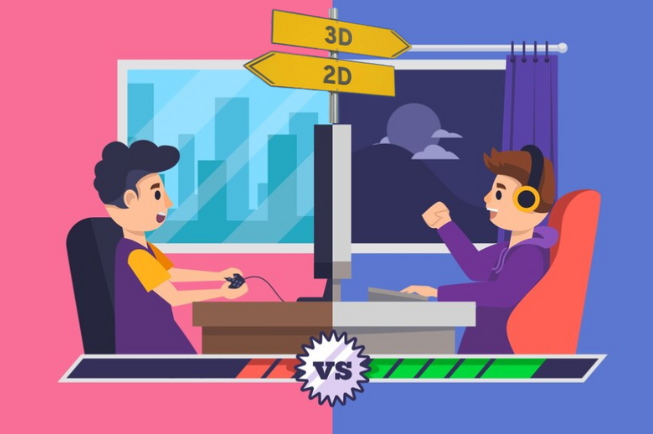2d animation vs 3d animation
2d animation vs 3d animation: Animation has significantly advanced from its early days of simple hand-drawn frames to the sophisticated computer-generated imagery (CGI) we see today. Two of the most prominent forms of animation are 2D animation and 3D animation, each with distinct techniques, styles, and applications. Understanding the differences between 2D animation vs 3D animation can help animators, artists, and enthusiasts select the appropriate medium for their projects. This article explores the intricacies of 2D animation vs 3D animation, comparing their characteristics, processes, and uses.
- What is 2D Animation?
- Definition and Overview
2D animation, or two-dimensional animation, involves creating movement in a two-dimensional space. Characters and backgrounds are created in flat formats, using only height and width dimensions. This traditional form of animation, seen in classic cartoons, remains widely used today.
2D animation vs 3D animation highlights the fundamental difference in dimensionality, with 2D being flat and 3D including depth. - History of 2D Animation
2D animation boasts a rich history, beginning with early flipbooks and evolving through the golden age of Disney cartoons. Key milestones include:- Early Techniques: Flipbooks and simple animation machines like the Zoetrope.
- Disney’s Innovations: Introduction of cel animation, where characters were drawn on transparent sheets and overlaid on static backgrounds.
- Modern Uses: 2D animation in television series, advertisements, and educational content.
The 2D animation vs 3D animation debate often considers historical context, with 2D having a longer history.
- Techniques in 2D Animation
- Hand-Drawn Animation: Each frame is drawn by hand, creating a sequence of images.
- Digital 2D Animation: Uses software like Adobe Animate or Toon Boom Harmony, allowing for more efficiency and flexibility.
- Cut-Out Animation: Involves creating characters and objects from cut-out shapes, often used in children’s programming.
The choice between 2D animation vs 3D animation techniques depends on the desired visual effect and production resources.
- The Process of 2D Animation
- Concept and Storyboarding: Developing the storyline and creating rough sketches of scenes.
- Character Design: Designing the appearance and features of characters.
- Animation Production: Drawing frames, either by hand or digitally, and creating in-betweens for smooth motion.
- Post-Production: Adding sound, special effects, and final edits.
When comparing 2D animation vs 3D animation, the production processes differ significantly in terms of complexity and tools.
- Definition and Overview
- What is 3D Animation?
- Definition and Overview
3D animation, or three-dimensional animation, involves creating moving images in a three-dimensional space. Unlike 2D animation, 3D animation includes depth, giving characters and scenes a more realistic appearance. This form of animation is prevalent in modern movies, video games, and virtual reality applications.
The discussion of 2D animation vs 3D animation often centers around the added dimension of depth in 3D animation. - History of 3D Animation
3D animation has rapidly evolved with advances in computer technology:- Early Innovations: The first 3D animations were simple wireframe models.
- Breakthrough Films: Pixar’s “Toy Story” marked a significant milestone as the first fully 3D-animated feature film.
- Modern Applications: Used extensively in blockbuster films, video games, and augmented reality (AR) experiences.
The evolution from 2D to 3D highlights significant advancements in the 2D animation vs 3D animation landscape.
- Techniques in 3D Animation
- Modeling: Creating 3D models of characters, objects, and environments using software like Blender or Autodesk Maya.
- Rigging: Building a skeleton for models, allowing them to be animated.
- Animation: Moving the models frame by frame or using motion capture technology.
- Rendering: Converting the 3D models and animations into final images or frames.
- Post-Production: Adding visual effects, sound, and final touches.
The process of 2D animation vs 3D animation techniques highlights the additional steps involved in 3D animation, including modeling and rendering.
- The Process of 3D Animation
- Concept and Storyboarding: Similar to 2D animation, involves planning the storyline and visual sequence.
- 3D Modeling: Creating detailed models of characters and settings.
- Texturing: Applying colors, textures, and materials to the 3D models.
- Rigging and Animation: Setting up the skeletal structure and animating the models.
- Lighting and Rendering: Adding light sources and rendering the final images.
- Post-Production: Compositing, sound editing, and final adjustments.
Comparing 2D animation vs 3D animation processes helps in understanding the depth and detail involved in 3D production.
- Definition and Overview
- Key Differences Between 2D and 3D Animation
- Visual Style
- 2D Animation: Often more stylized and abstract, focusing on artistic expression.
- 3D Animation: Typically aims for realism, with detailed textures and lighting.
The visual style is a major point in the 2D animation vs 3D animation comparison.
- Complexity and Tools
- 2D Animation: Generally simpler, requiring less complex software and hardware.
- 3D Animation: More complex, needing powerful computers and specialized software.
The 2D animation vs 3D animation complexity often reflects the resources and expertise required.
- Time and Cost
- 2D Animation: Can be quicker and cheaper for simpler projects.
- 3D Animation: Often more time-consuming and expensive due to the detailed modeling and rendering process.
The cost and time involved in 2D animation vs 3D animation can vary greatly based on project scope.
- Applications
- 2D Animation: Common in TV shows, web series, and educational videos.
- 3D Animation: Widely used in movies, video games, and virtual/augmented reality.
The application of 2D animation vs 3D animation depends on the intended use and audience.
- Visual Style
- Advantages and Disadvantages
- 2D Animation
- Advantages:
- Artistic Flexibility: Easier to create unique styles and artistic expressions.
- Lower Costs: Generally cheaper to produce.
- Simplicity: Easier to learn and execute with basic tools.
- Disadvantages:
- Lack of Depth: Limited to two dimensions, lacking the realism of 3D animation.
- Less Versatility: Not ideal for projects requiring high realism.
Comparing 2D animation vs 3D animation advantages and disadvantages helps in determining the best medium for specific needs.
- Advantages:
- 3D Animation
- Advantages:
- Realism: Capable of creating highly realistic characters and environments.
- Versatility: Suitable for a wide range of applications, from films to virtual reality.
- Advanced Effects: Allows for complex visual effects and dynamic simulations.
- Disadvantages:
- Cost: More expensive due to the need for specialized software and hardware.
- Complexity: Requires a higher level of skill and more time to produce.
The 2D animation vs 3D animation discussion often includes a detailed look at the pros and cons of each.
- Advantages:
- 2D Animation
- Choosing Between 2D and 3D Animation
- Project Requirements
- Artistic Style: Consider the visual style and artistic direction of the project.
- Budget and Time: Evaluate the available budget and timeline.
- Target Audience: Think about the preferences of the intended audience.
- Technical Skills: Assess the skills and expertise of the animation team.
The decision of 2D animation vs 3D animation often hinges on these project-specific factors.
- Case Studies
- 2D Animation: “The Simpsons” – A successful TV series with a distinct 2D animation style.
- 3D Animation: “Frozen” – A blockbuster film showcasing the capabilities of 3D animation.
Real-world examples of 2D animation vs 3D animation help illustrate the application and impact of each.
- Project Requirements
FAQs
- What are the primary tools used in 2D animation?
Common tools include Adobe Animate, Toon Boom Harmony, and TVPaint. These tools facilitate the creation of hand-drawn or digital 2D animations with various features for drawing, rigging, and animating characters. - How does the learning curve compare between 2D and 3D animation?
Generally, 2D animation has a gentler learning curve compared to 3D animation. 3D animation involves mastering more complex software and understanding concepts like modeling, rigging, and rendering, which can take longer to learn. - Can 2D and 3D animation be combined in a single project?
Yes, combining 2D and 3D animation is possible and often used to create visually unique and engaging content. Some films and video games use 3D backgrounds with 2D characters, or vice versa, to achieve a specific artistic style or effect.
Conclusion
Both 2D and 3D animation offer unique advantages and challenges, making them suitable for different types of projects. While 2D


